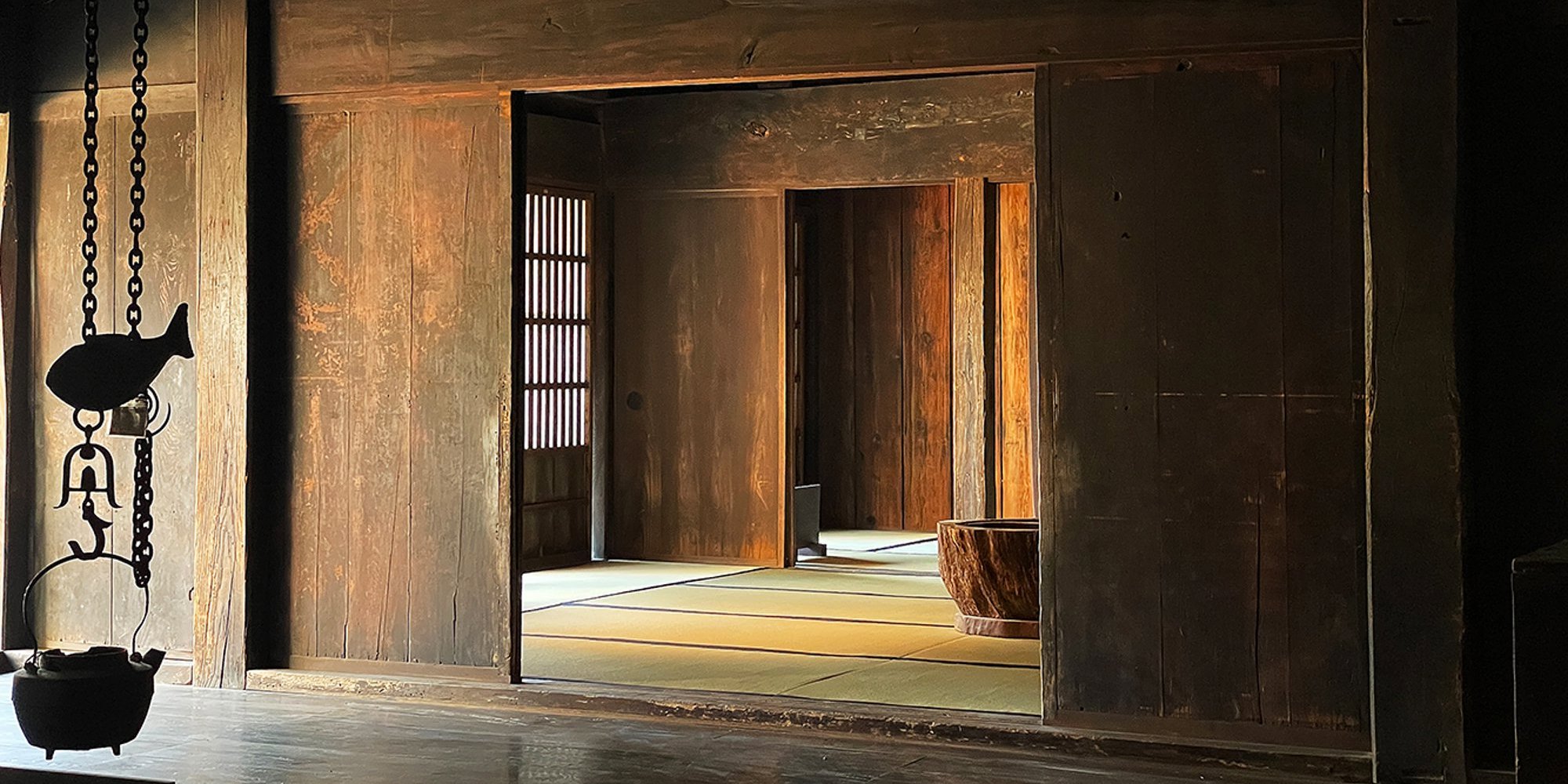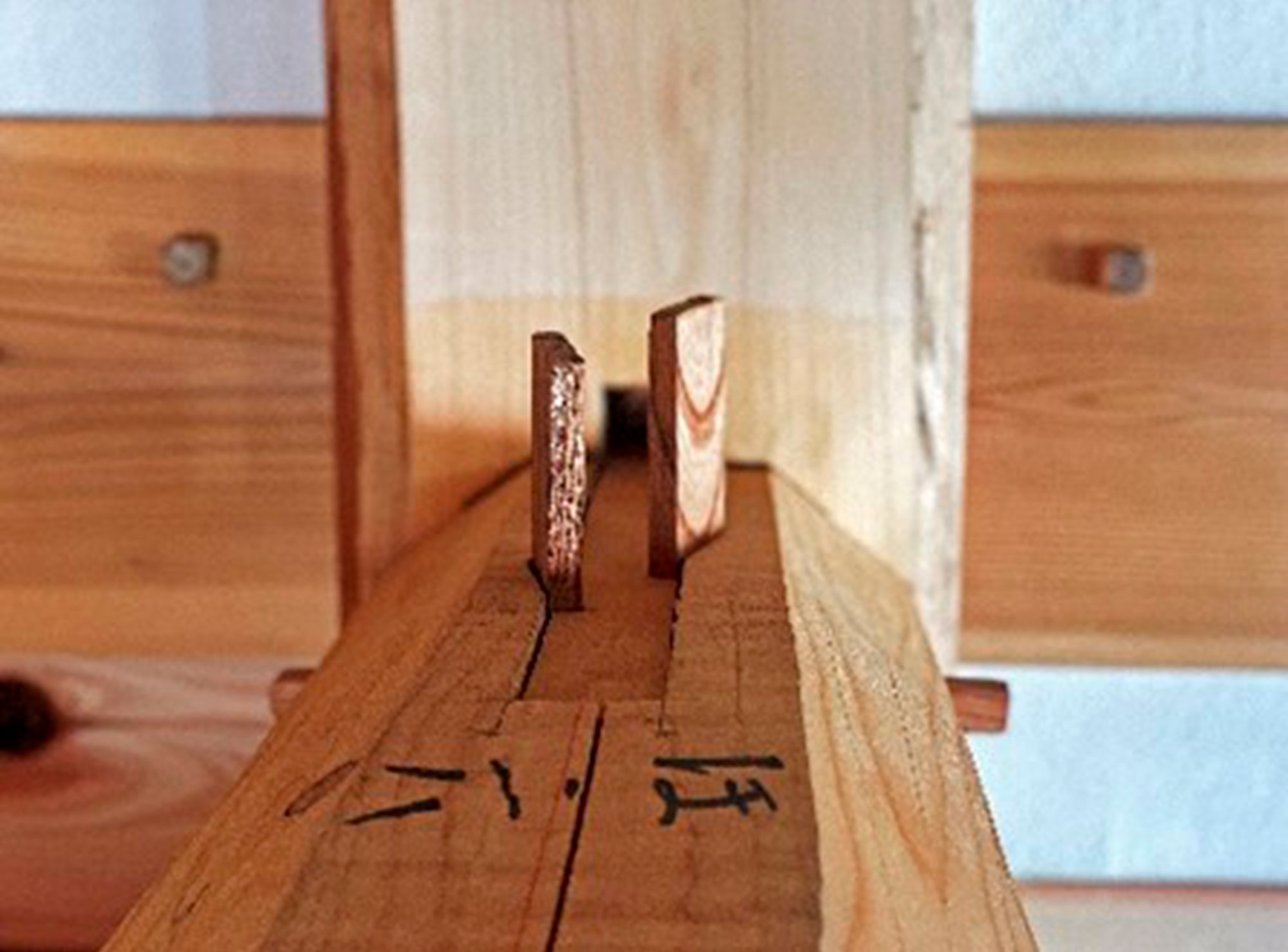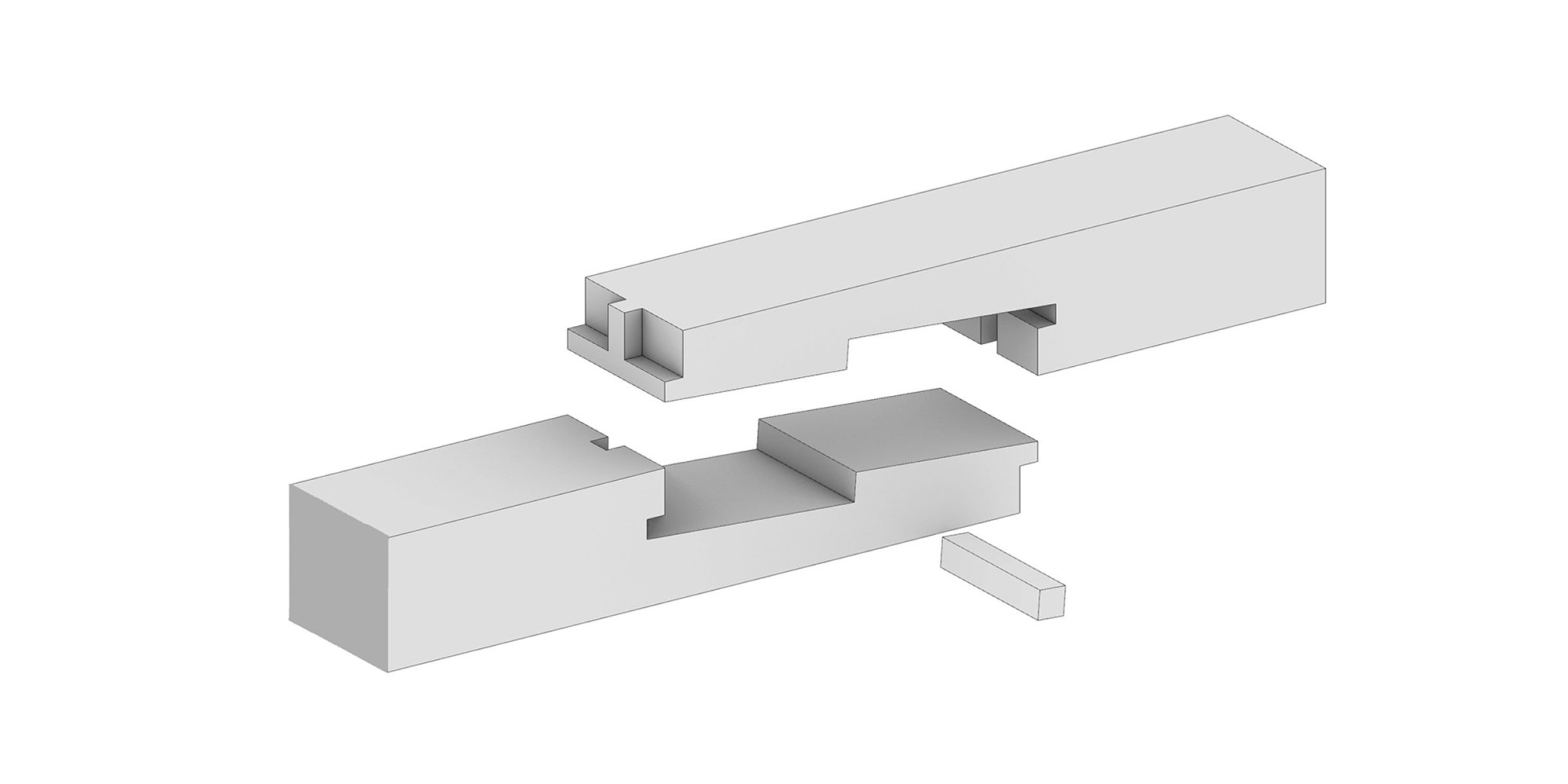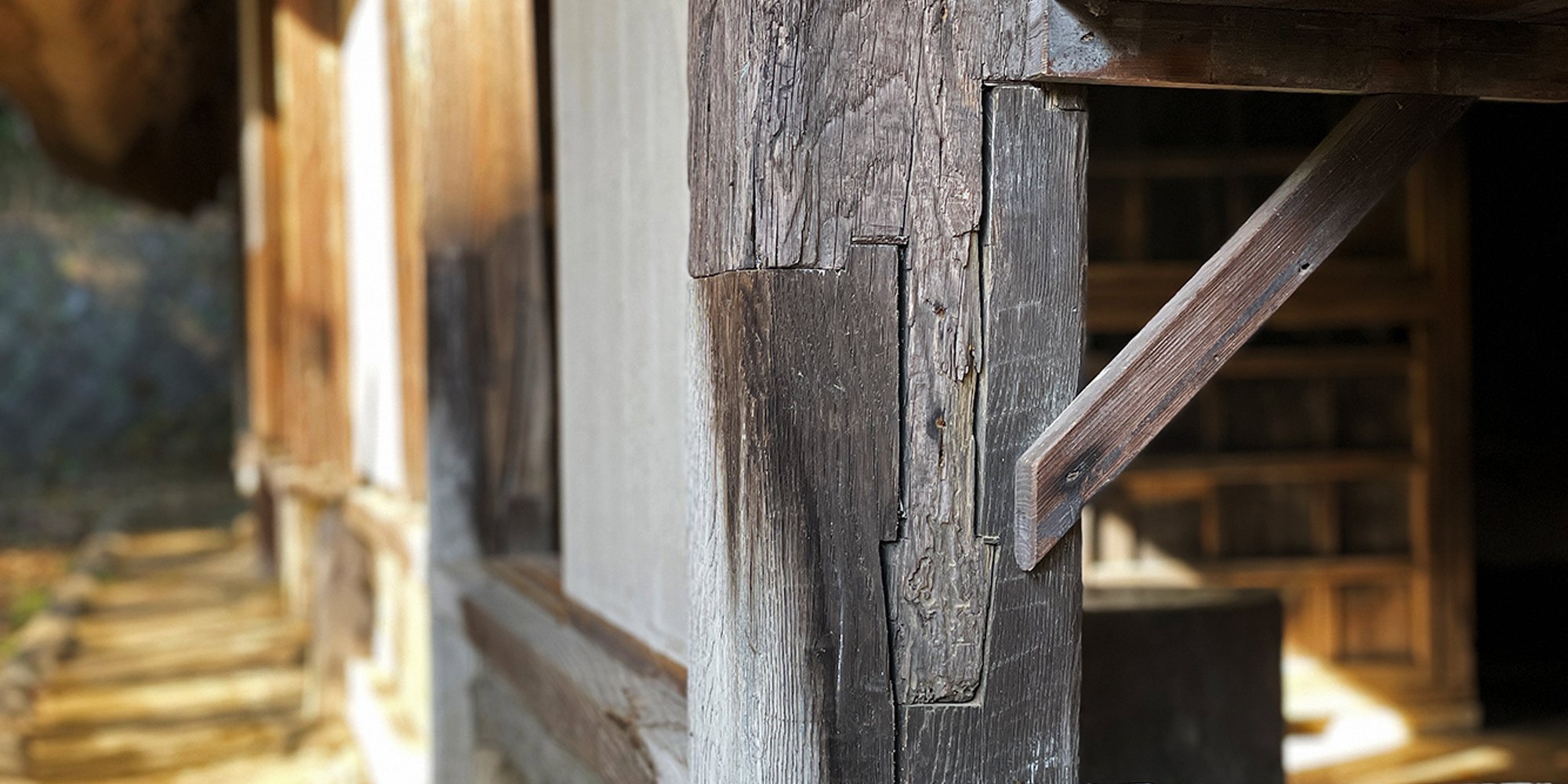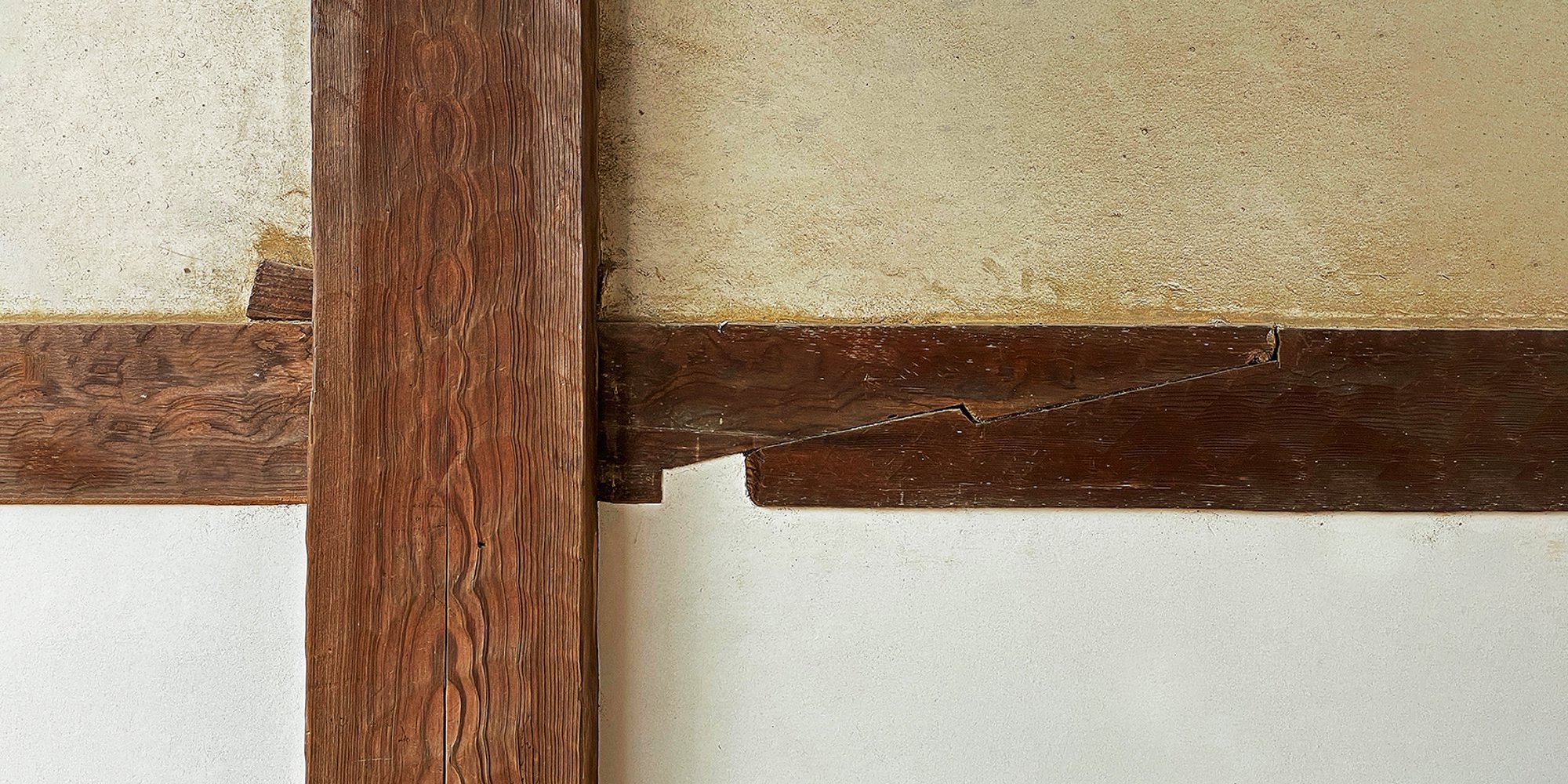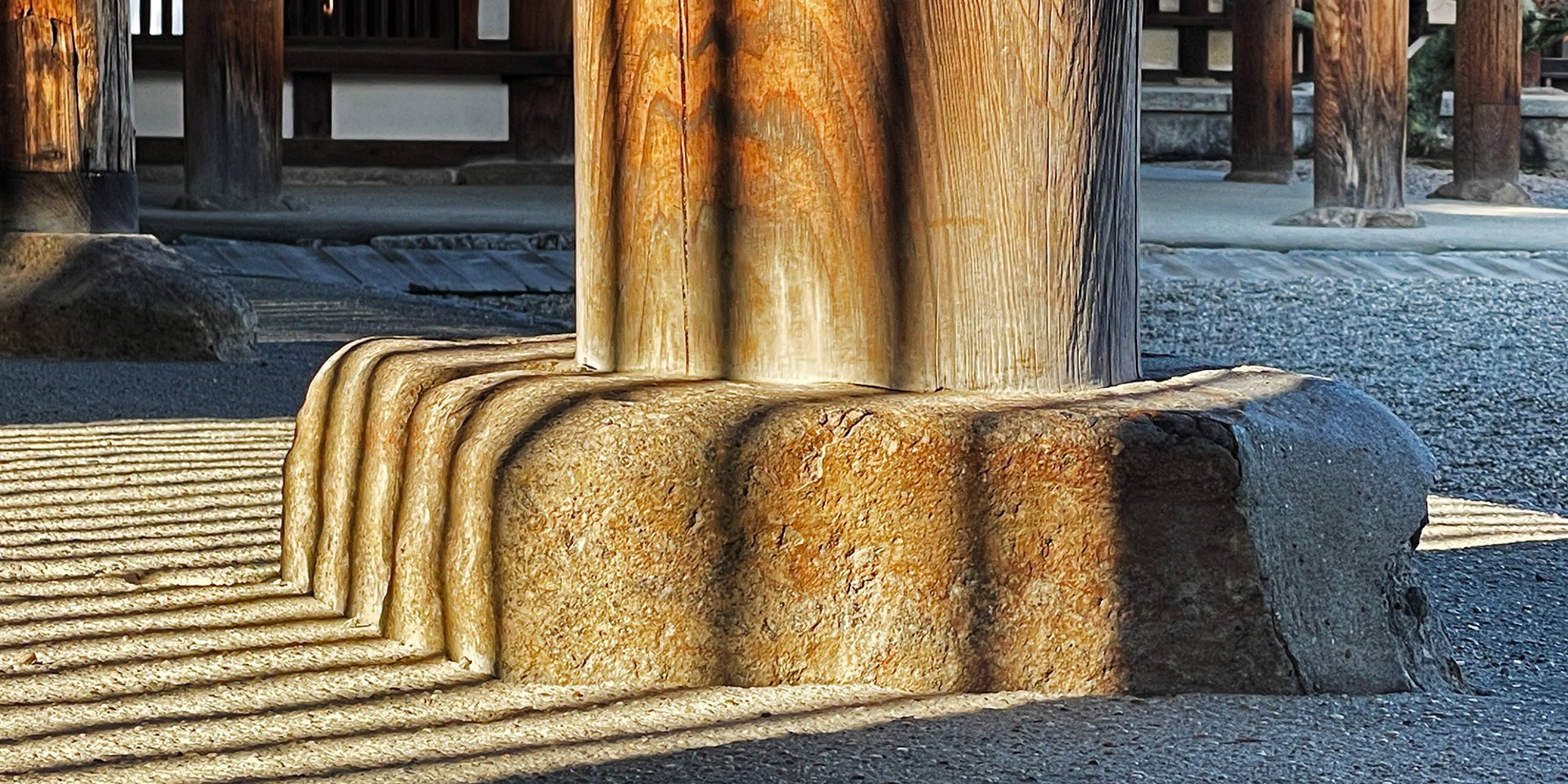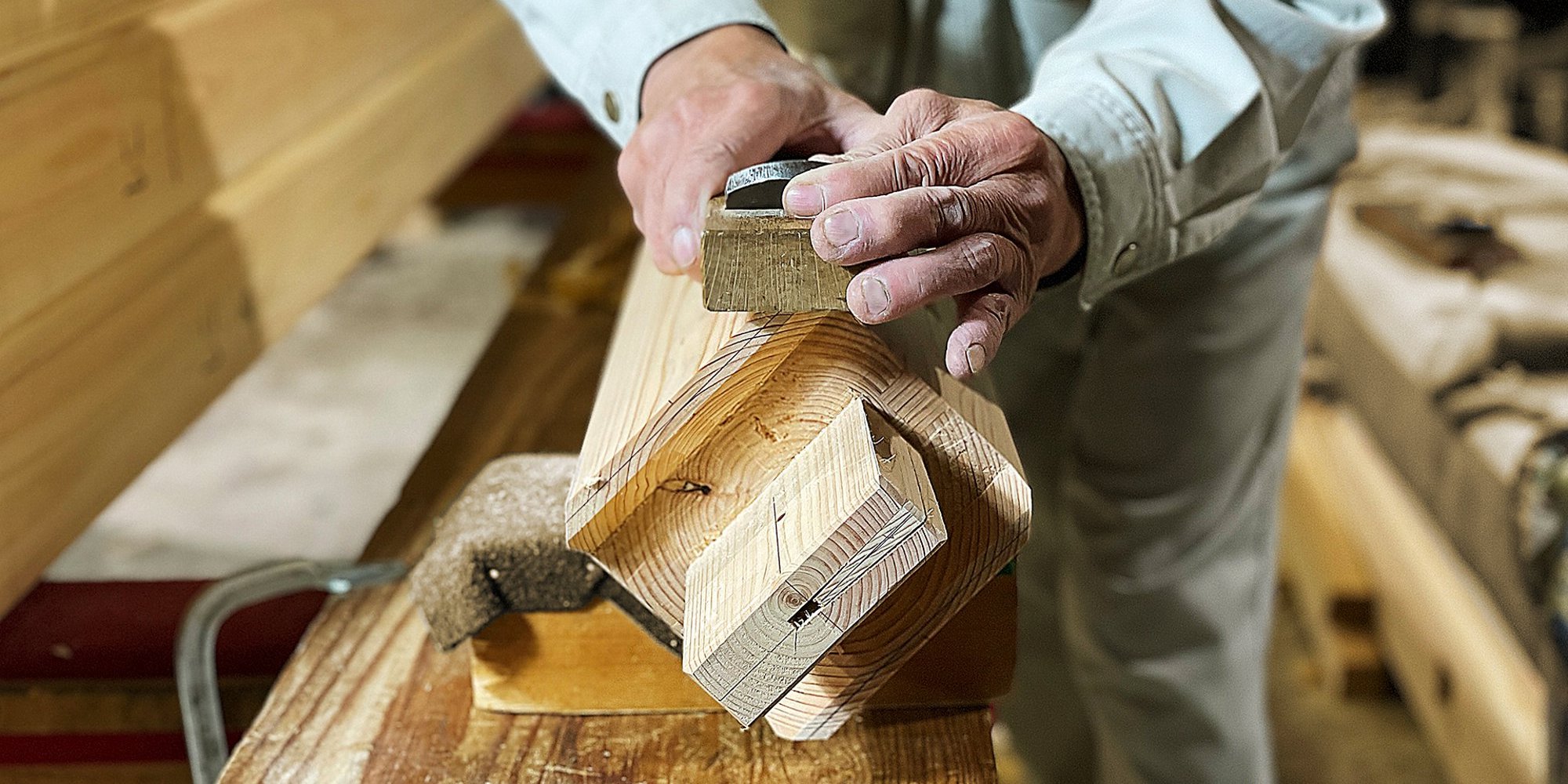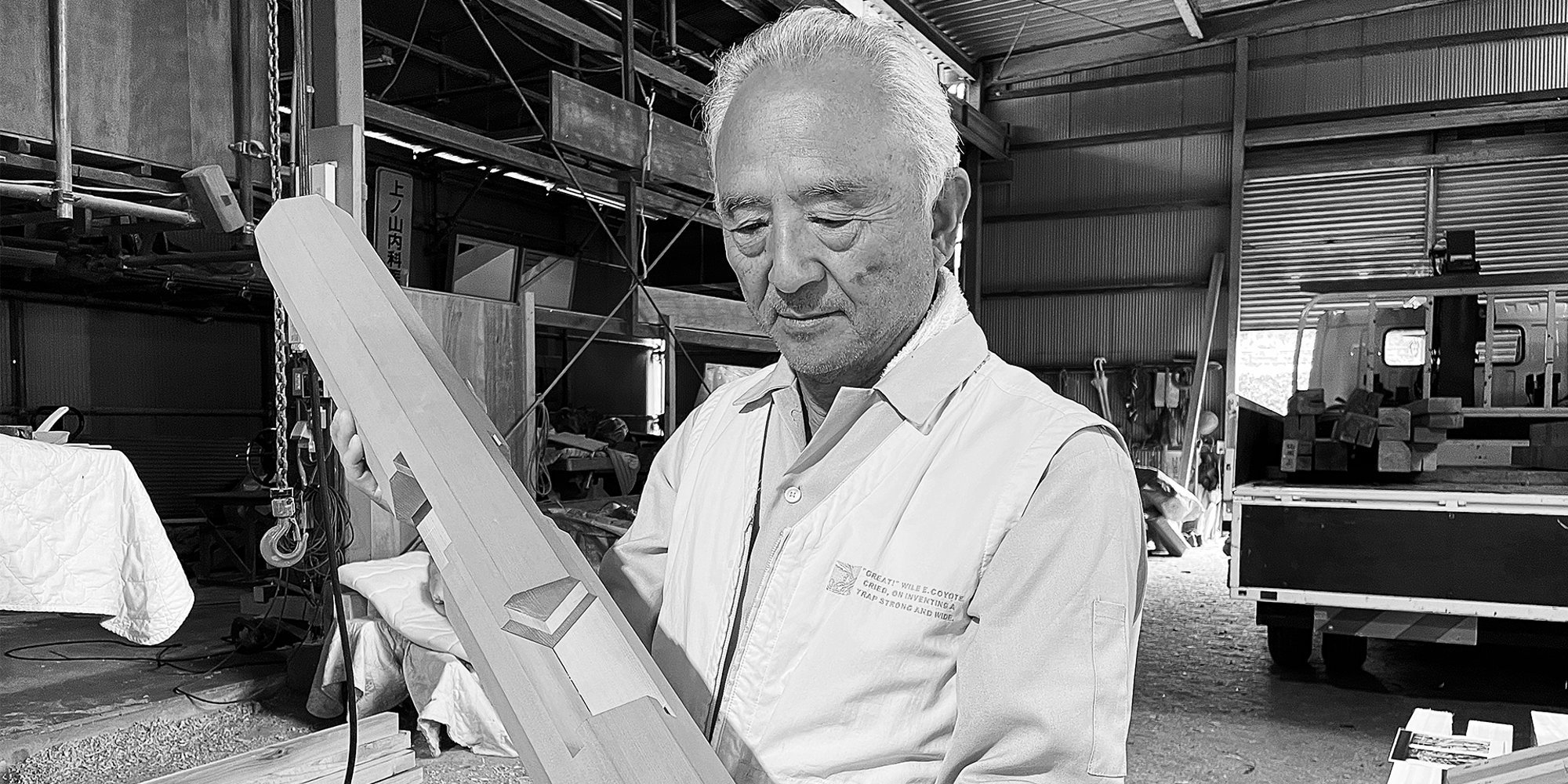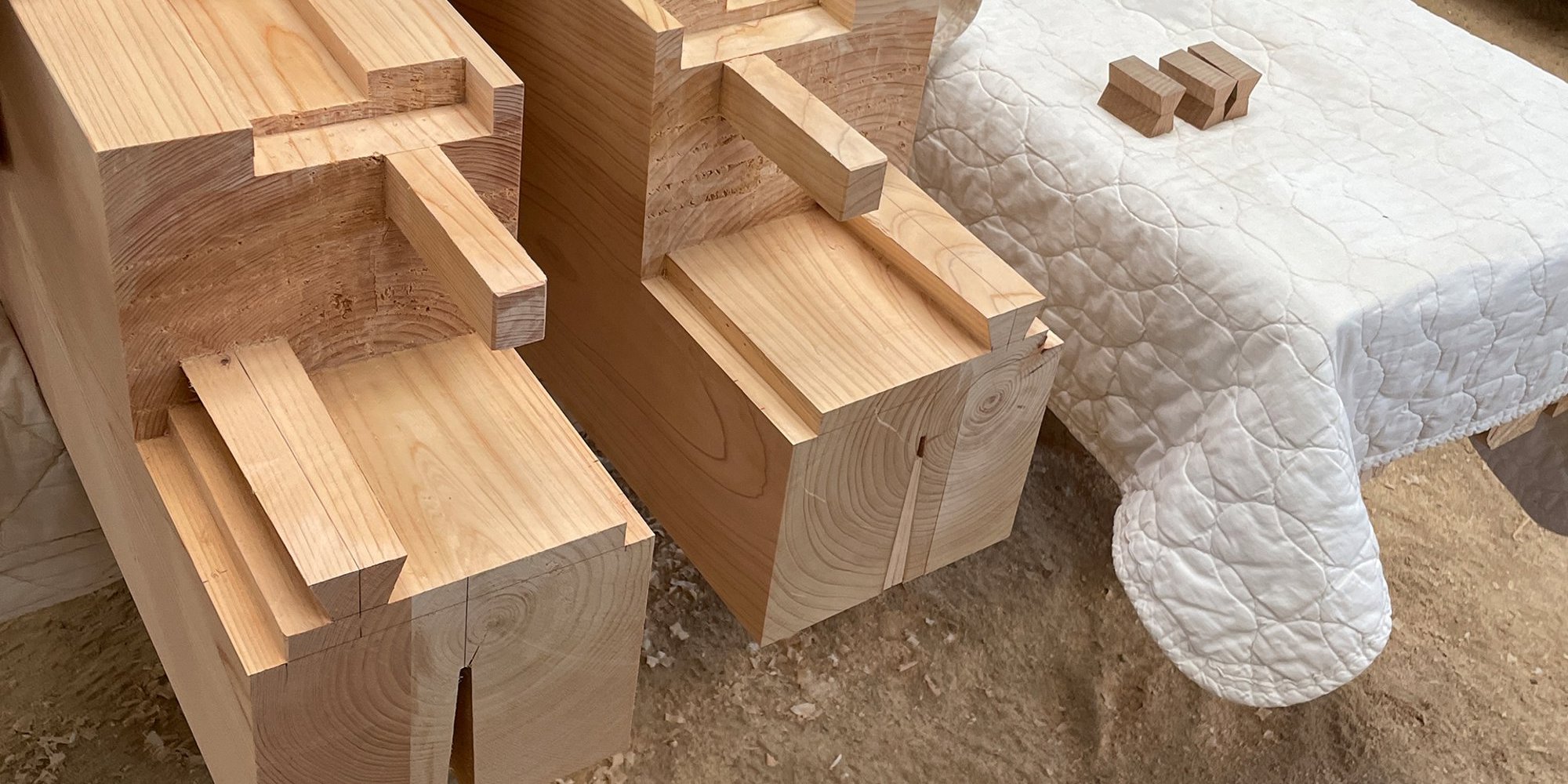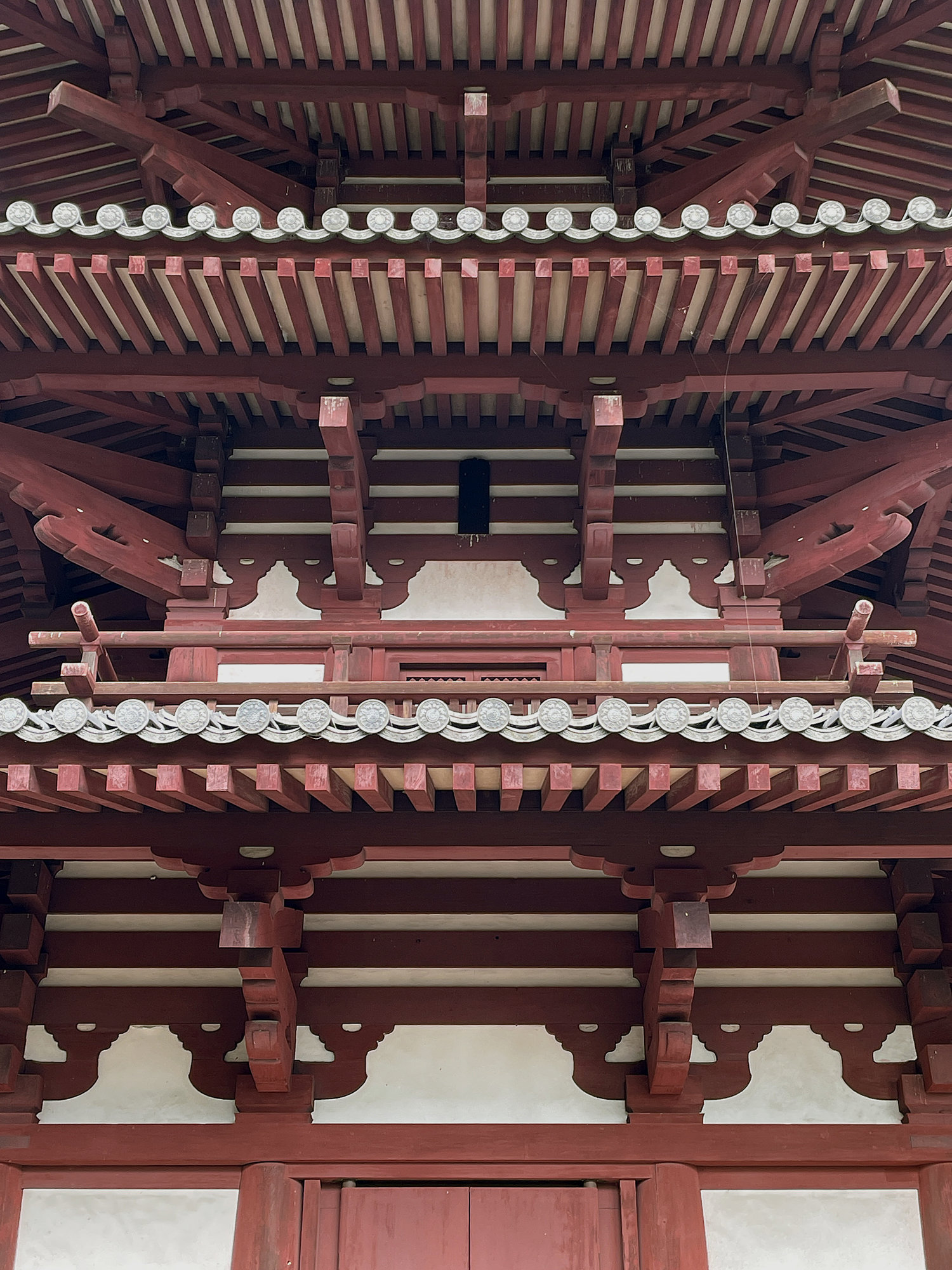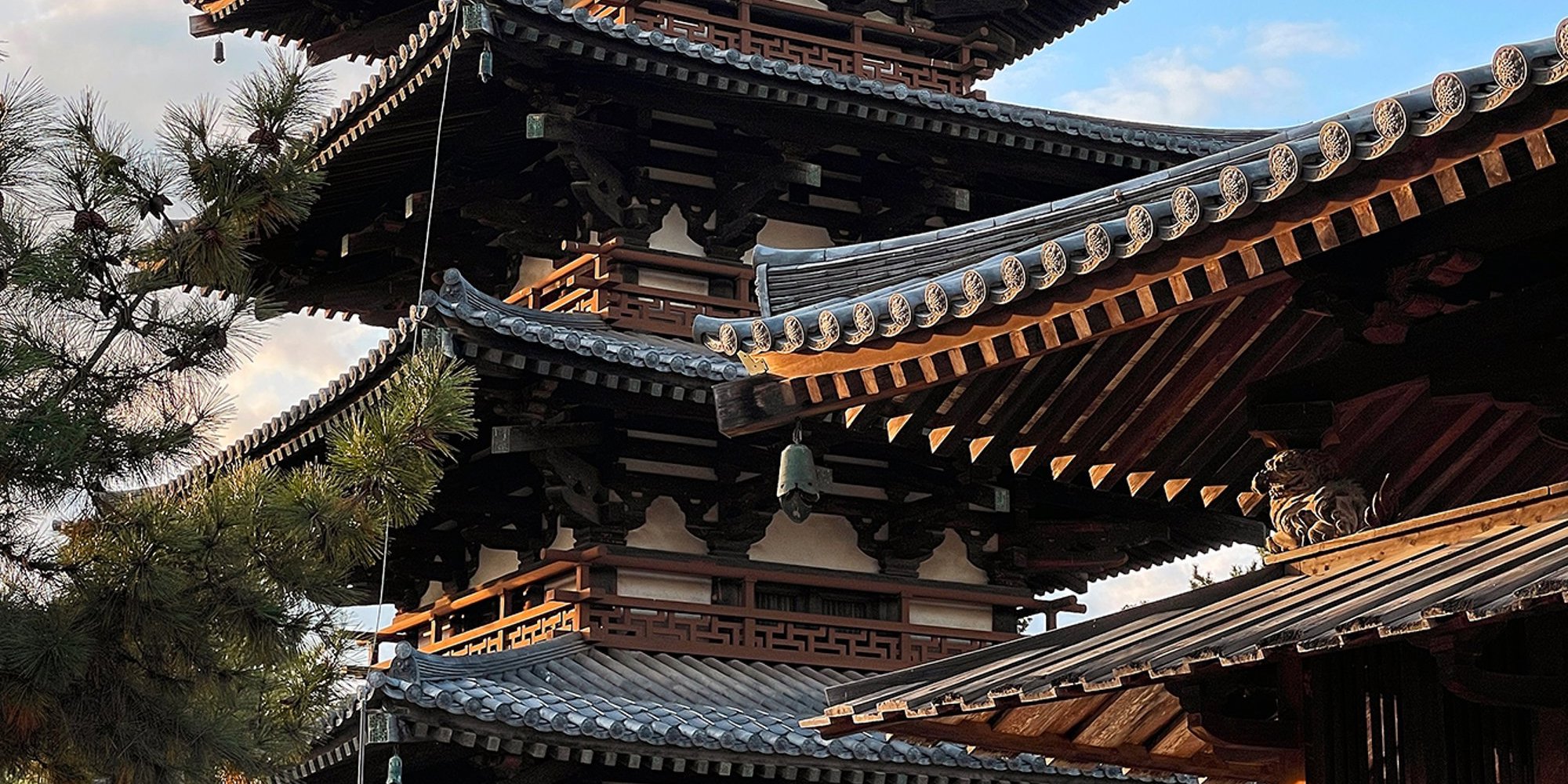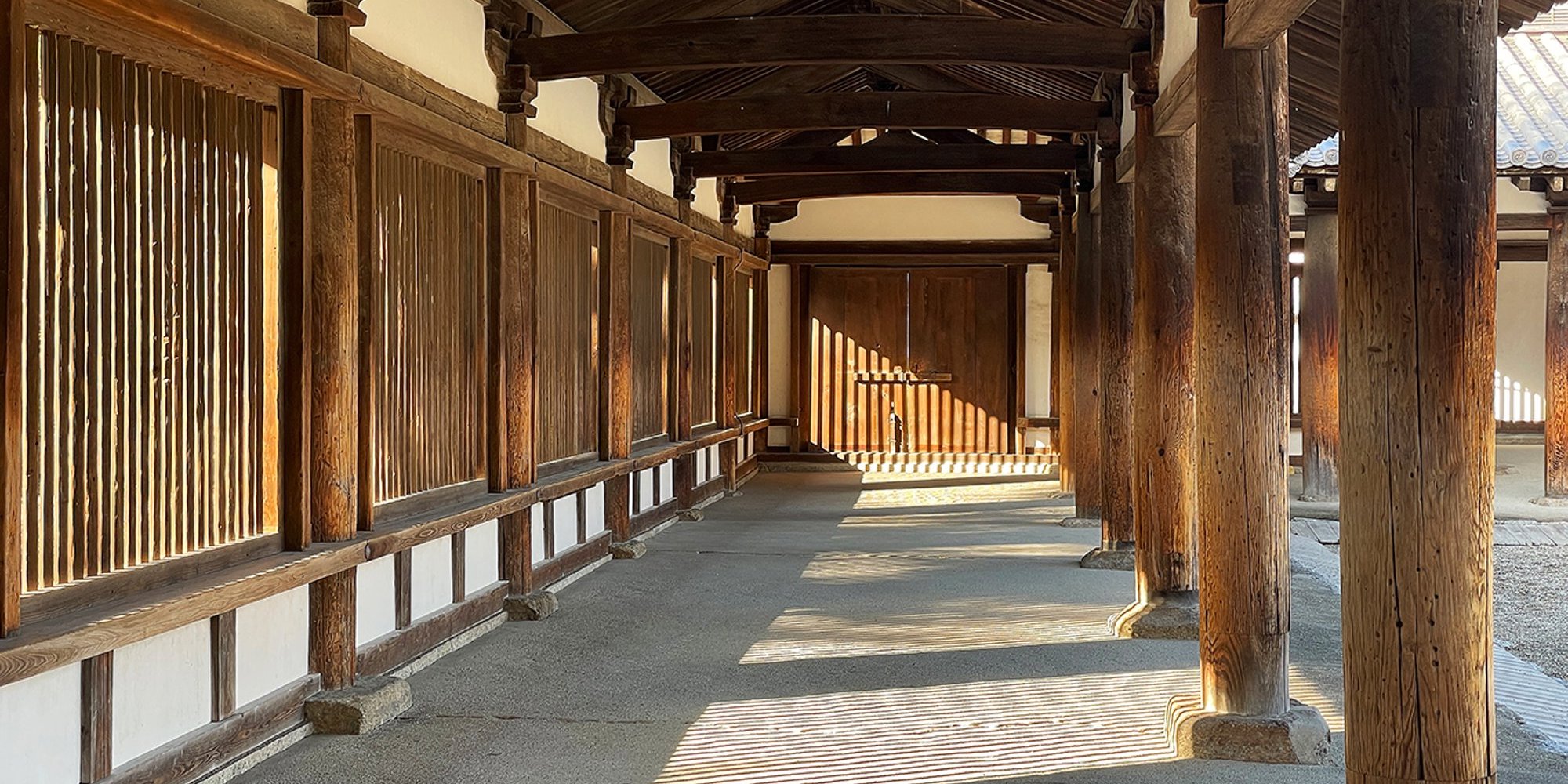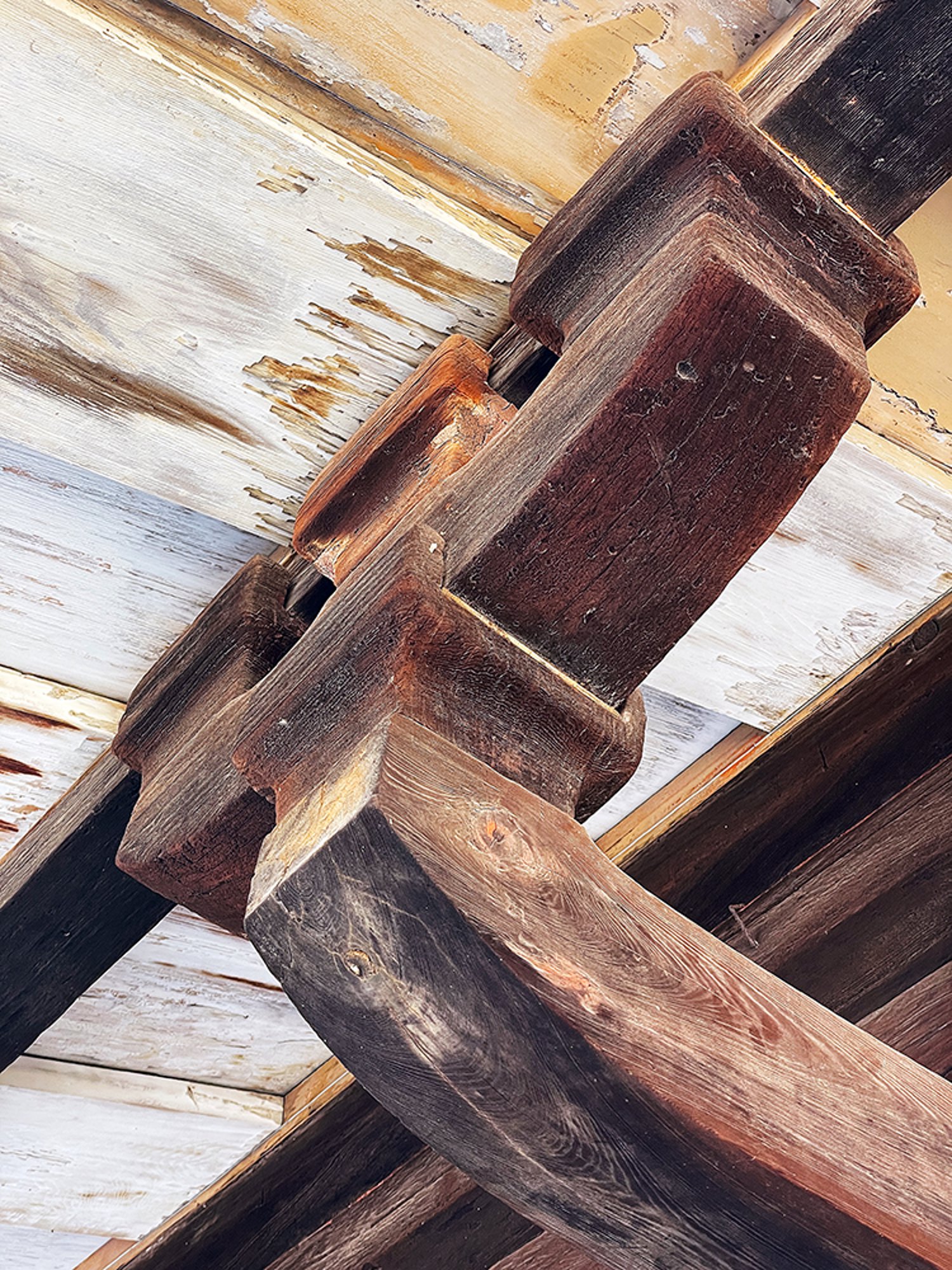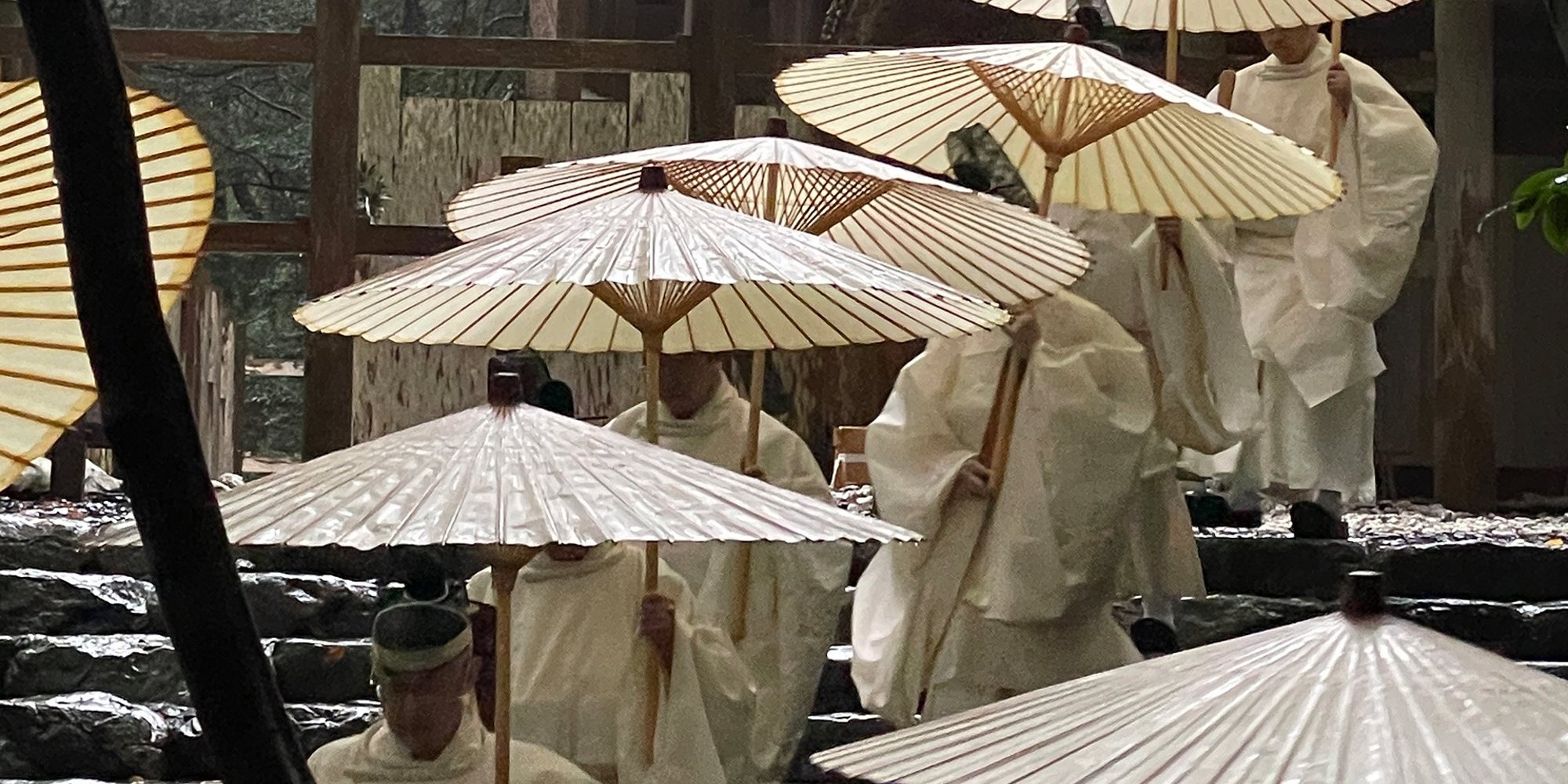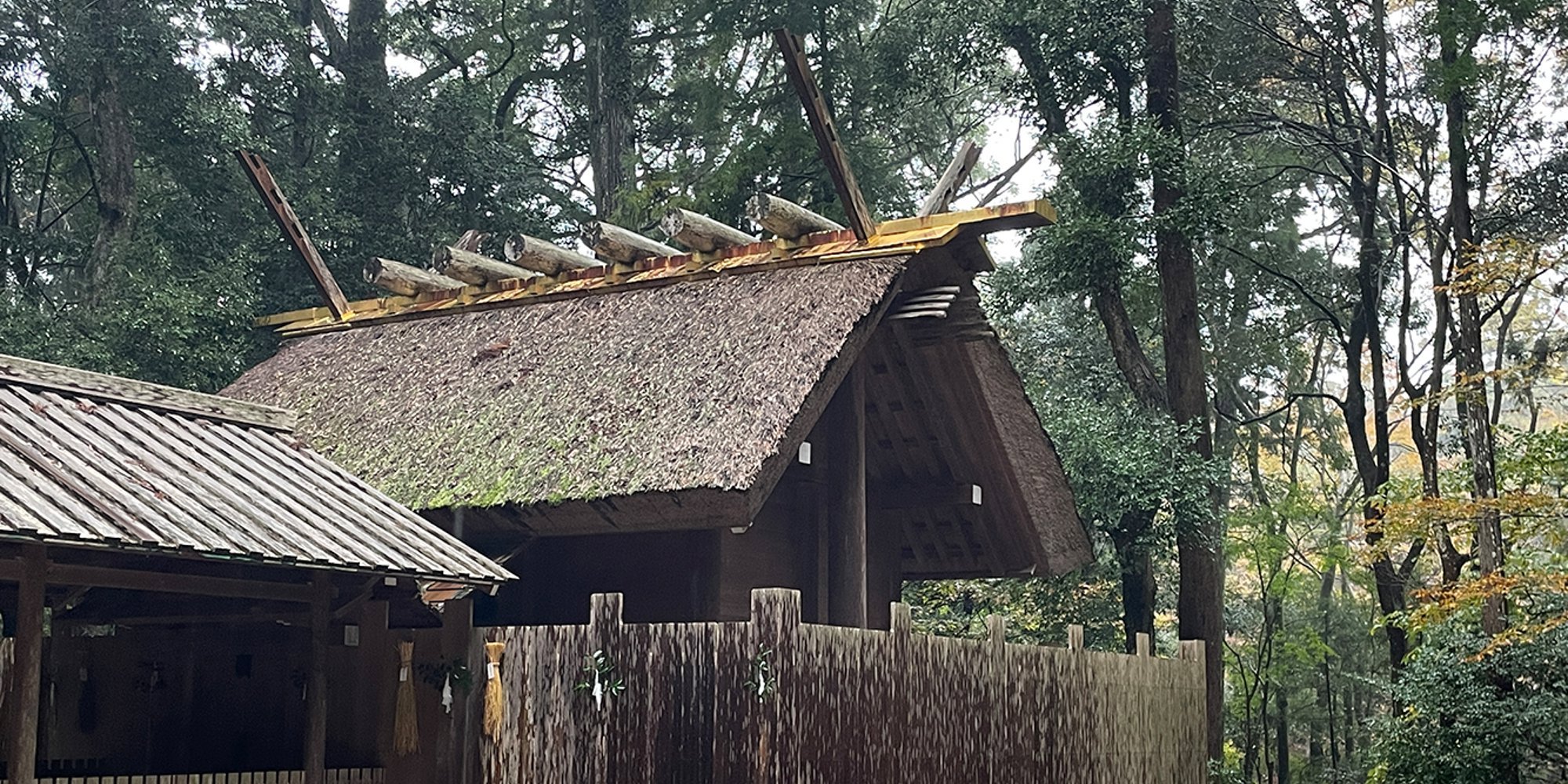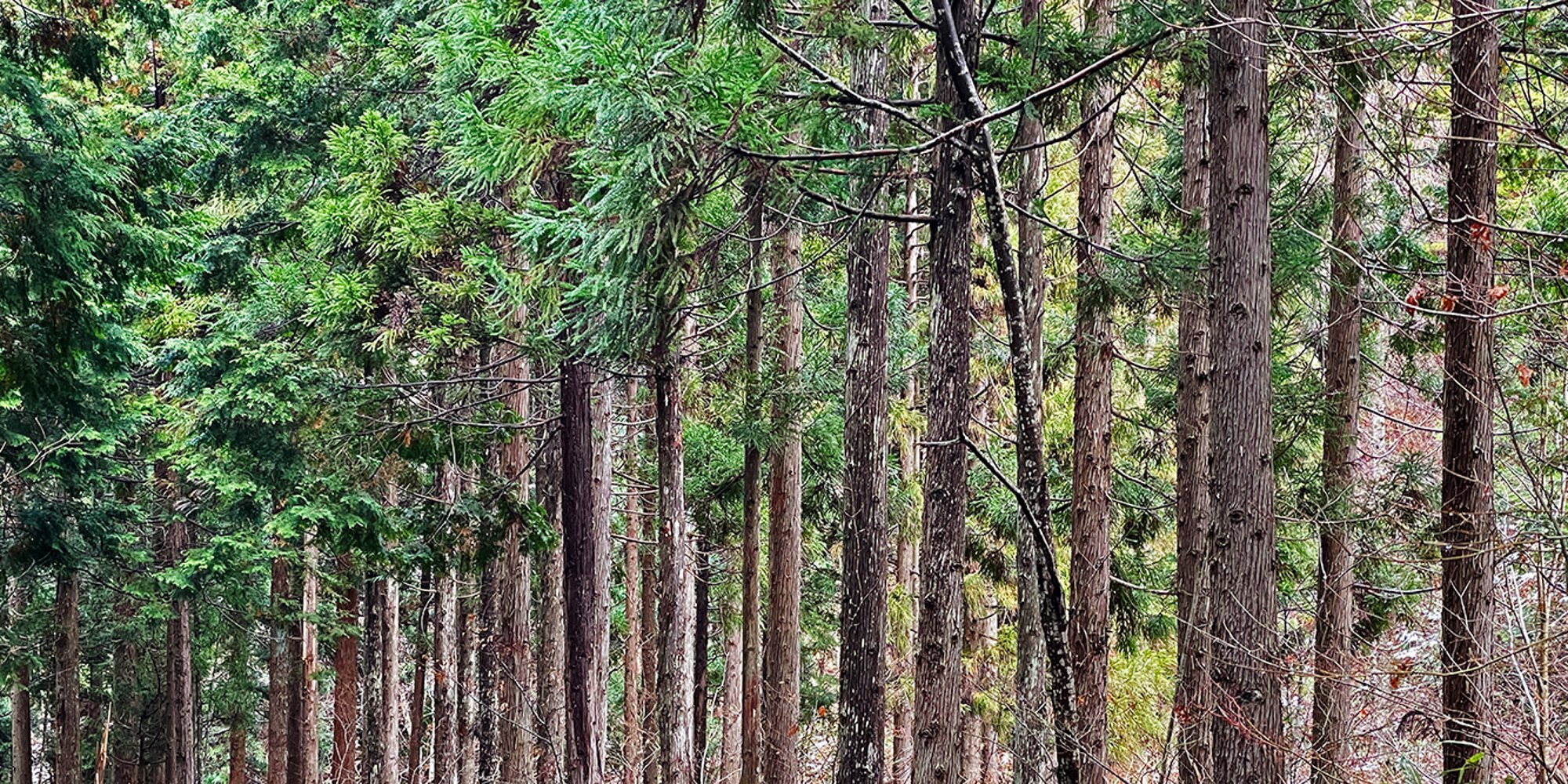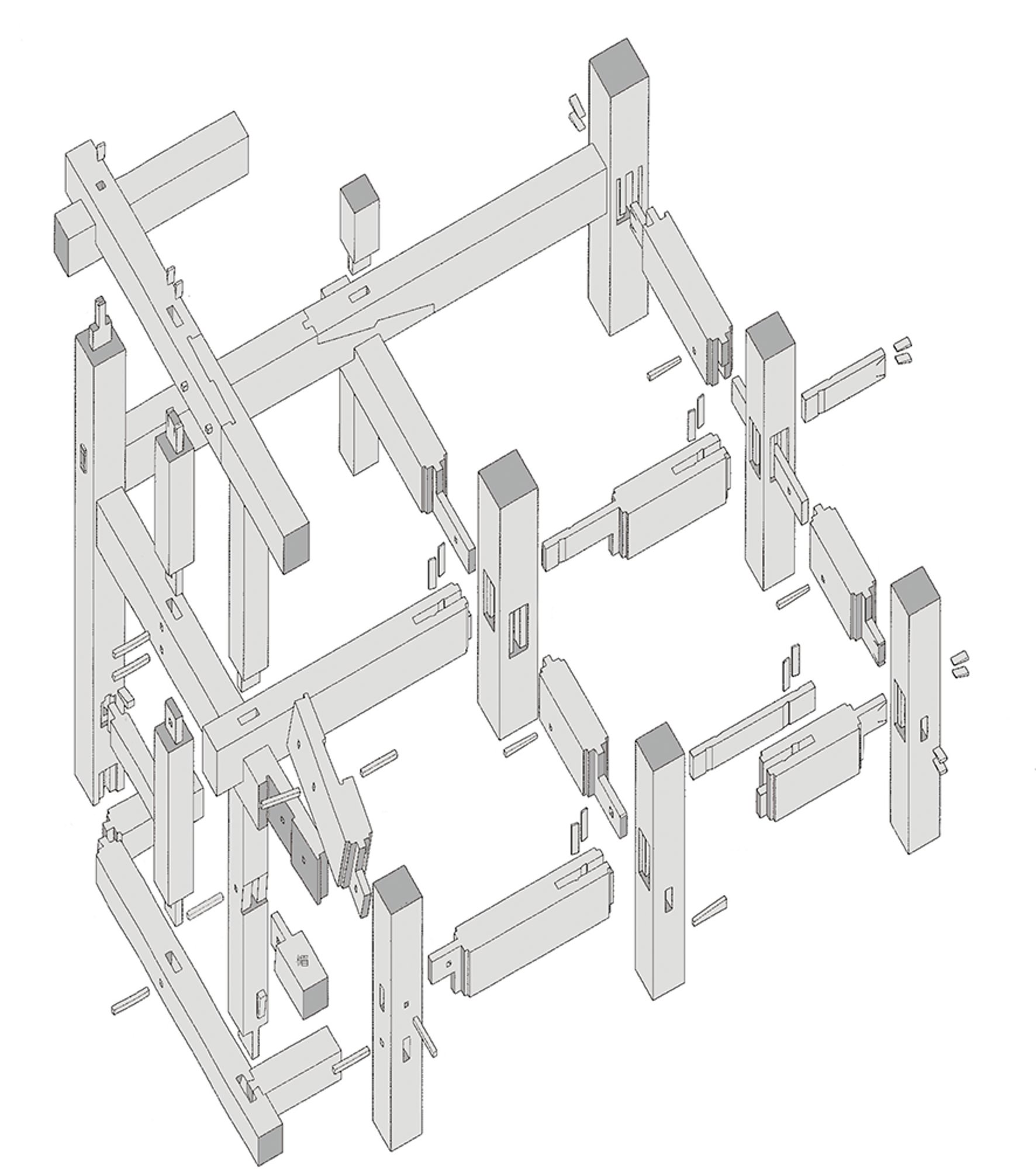Complex timber-only joints have been at the heart of Japanese architectural design for centuries, featuring in some of the oldest buildings in the world. Richard Maddock, Design Systems Analyst at Foster + Partners, considers how timber structures can offer innovative, sustainable, and long-lasting design solutions for architects today.
20th July 2023
Fibre to Fibre: Japanese Timber Joinery
In 2020, I was awarded a Churchill Fellowship to investigate Japanese timber joinery and its potential relationship with contemporary robotic fabrication. The first part of my Fellowship, undertaken once borders re-opened after the pandemic, involved a research tour across Japan. There, I visited many notable structures, including the world’s oldest timber building, and met with craftsmen, architects, and engineers whose work ranged from traditional to innovative and whose designs featured interlocking timber-only connections.
The ancient Japanese attitude of building for longevity is strikingly contemporary; timber-only joints are not only beautiful and functional but sustainable and adaptable, offering convincing solutions to many of our construction problems today. My final report provides a complex overview of timber-only construction but, in this edited extract, I focus on my findings from Japan, where the age-old practice of timber joinery continues, and consider how these skills can offer innovative, sustainable, and long-lasting design solutions for architects today.
Japanese Joints
Complex joints have been at the heart of Japanese architectural design for centuries and for generations have remained closely guarded secrets among carpenters. Each different type of traditional timber construction in Japan – including tea houses, townhouses, and temples – has its own unique history, aesthetic design, and set of engineering requirements. Each has its own specialist carpenter, too.
The proliferation of several hundred types of timber joints – such as the Saotsugi and Kanawa-tsugi – throughout Japanese architecture is a testament to the skills and commitments of the individual craftsmen. Not all joints are in all types of construction; sometimes, one joint is solely used in one building type. A building’s carpenter might use a traditional joint that provides structural support; they might use another joint in an unexpected and thoughtful way; they might even develop a new joint that is particular to the building, demonstrating a craftsman’s scope for innovation and creativity.
The Saotsugi joint is often used for large beams in Japanese construction. The wedge’s mortise needs to be tapered both on the front and back abutments, and the wedge must taper both in width and thickness to fit the mortise. There are many variations of this joint to cater to different structural conditions, such as adding a cross-wise spline (to reinforce against vertical loads), increasing the number of tenons (to increase the strength of the joint), or making the tenons full height (to reinforce against torsion). © Richard Maddock
The Saotsugi joint is often used for large beams in Japanese construction. The wedge’s mortise needs to be tapered both on the front and back abutments, and the wedge must taper both in width and thickness to fit the mortise. There are many variations of this joint to cater to different structural conditions, such as adding a cross-wise spline (to reinforce against vertical loads), increasing the number of tenons (to increase the strength of the joint), or making the tenons full height (to reinforce against torsion). © Richard Maddock
Where Western joints are classified by their manner of joining – for example, lap joints or dovetails – in Japan, joints are classified according to their function – either splicing (tsugite) or connecting (shiguchi). This represents a fundamental difference in how joints are thought about and is another key divergence between Japan and the rest of the world.
Often used for the underpinning of columns, the Kanawa-tsugi joint is particularly favoured because the key is a wedge, helping to create a firm joint. Occasionally the joint is reinforced with a strap, becoming as strong as a sound piece of timber of the same dimensions. The tools required to make this joint are quite advanced, so it is certain that this joint was only devised and perfected during the Edo period (1603 – 1867). © Richard Maddock
Often used for the underpinning of columns, the Kanawa-tsugi joint is particularly favoured because the key is a wedge, helping to create a firm joint. Occasionally the joint is reinforced with a strap, becoming as strong as a sound piece of timber of the same dimensions. The tools required to make this joint are quite advanced, so it is certain that this joint was only devised and perfected during the Edo period (1603 – 1867). © Richard Maddock
Timber-only joints in a Japanese context have three main benefits. First, they increase a building’s lifespan by hundreds of years. The geological scarcity of iron in Japan meant that carpenters built without nails or bolts; this reduced degradation caused by rusting and, consequently, created longer-lasting structures. Second, since timber-only joints are not as rigid as ‘fixed’ joints, they can withstand seismic activity better. In an earthquake, the energy imparted by the ground shaking is dissipated through friction in the joints. This is why some of the oldest timber structures in Japan have survived, despite being jolted frequently by tremors. Third, timber-only connections assist maintenance and repair tasks, especially in the way they have been designed and crafted by Japanese carpenters. Most joints are easily taken apart, enabling entire buildings to be disassembled, relocated, and reassembled with relative ease. The building is a living project, readily available to teach and train the carpenters who maintain it.
Two further ingredients are needed to produce a functional and long-lasting structure with timber-only joints: steel and stone. The sharp steel blades used to shape timber can cut joints to extremely high precision, ensuring structural integrity. They also cut the fibres of the timber so effectively that the wood can better repel water, lengthening the structure’s lifespan. Similarly, the stone used at the base of timber columns elevates the wood away from water, preventing rot. This arrangement also acts as a base isolator, allowing the posts to slip side to side on the stone footings in the event of an earthquake, reducing the risk of collapse.
However, what is most critical when constructing long-lasting wooden buildings is that the nature of the timber is respected and its behaviour over time understood. Supported by their steel tools and stone foundations, carpenters follow the core principle of putting the right wood in the right place.
Japanese craftsmen understood that timber is not inert – unlike steel, or stone, or concrete – it is a collection of cells, just like us. And, just like us, trees have been shaped by the evolutionary forces that drive the cycle of every living thing on earth. When we design buildings to have a timber structure today, we need to acknowledge this fact, and consider its influence on the properties of the material we wish to build with.
There exists no other material that can handle complex interlocking joints with such alacrity: no other material is strong enough, and no other material possesses the requisite unique combination of properties.
Indeed, if we take this material understanding from Japanese tradition and apply it to modern timber construction, we can best exploit its natural structural versatility and sustainable benefits. Timber is CO2 neutral, sturdy, thermally insulating, aromatic, and is widely considered to have positive effects on human wellbeing. By optimizing timber connections and understanding the properties of timber, we can enhance its structural performance and create durable, eco-friendly structures that are not only functional but also aesthetically pleasing and beneficial for occupants.
Mitsuo Ogawa: Master Carpenter
In Japan, the millennia-old principle – right wood, right place – endures today. On my travels, I was privileged enough to meet with Japan’s most revered carpenter, Mitsuo Ogawa. Hailing from Tochigi prefecture, Ogawa was the son of a banker but was disinherited when he left home to become a temple carpenter. After becoming the only apprentice to the great Tsunekazu Nishioka, the last descendant of Japan’s most famous carpenter family, Ogawa’s first job was the reconstruction of the three-tier pagoda at Horinji (originally 7th century; reconstructed 1975; Nara, Japan), before working on some of the most prestigious timber buildings in Japan. In 1977, Ogawa founded Ikaruga Kosha, a temple carpenters’ school which adopts a unique apprenticeship system, allowing essential teaching to be passed on to the next generation.
When I asked Ogawa about his time rebuilding Horinji Temple after a fire, he shared with me how difficult the task was, and how important precise joints are to the successful construction of large, long-lasting timber buildings. His holistic – yet always precise – practice is clear:
If you look closely at the finial, you can see that the sorin [vertical shaft that tops the pagoda] is subtly leaning towards the south. This is because the sun is in the south and it hits the south side of the building. The state of the material allows it. When the sun hits that part of the structure that’s where it shrinks. When we get a tree from the forest, we try our best to get the tree that faces the same direction. The part of the tree that faces south is used so that its south side faces south in the building, for example at Tegaimon Gate at Todaiji in Nara.
Ogawa’s approach distils the best of traditional Japanese architecture, demonstrating a complex understanding of how environment, material, and building are in communion. This practice is not only sustainable – by carefully repairing buildings using local materials and craftsmanship with an emphasis on longevity – but it honours the materiality of the wood itself – a structure with an organic history, both grown with and responsive to sunlight and rain. The following case studies, Horyuji Temple and Ise Jingu, encourage such material and cultural sensitivity. Their caretakers understand maintenance and repair as an essential – not irksome – part of a building’s longevity.
Case Study: Horyuji Temple
The world’s oldest wooden building, built in the 7th century, Horyuji Temple was the first site in Japan to be UNESCO World Heritage listed in 1993, owing to its ‘masterpieces of wooden architecture, both in overall design and in decoration.’ Repair work has been carried out roughly every 200 years since it was first constructed – beginning in the Heian period (794-1185), with the most recent repairs taking place during the Great Showa Restoration of 1934-54 under the auspices of Nishioka. For centuries, the temple has survived a multitude of tremors, typhoons, and torrential rain, and stands strong today as a testament to the skill and dedication of its carpenters and caretakers.
Although the architecture of Horyuji has clear Buddhist influences hailing from China, the huge cypress trees that were once abundant in Japan enabled a distinct type of indigenous architecture to evolve. Consisting of a five-storey pagoda, main hall, southern gate, and corridors linking the oldest extant timber buildings in the world, Horyuji is a masterclass in Japanese temple design. Buildings are arranged in the compound according to their size, height, and function. It is no accident that one building rarely falls into the shadow of another; the original carpenters of Horyuji were aware that shadows prevent drying, encouraging unwanted rot.
Because the cypress was shaped by hand, naturally some places are more overworked than others; this mismatching is noticeable almost everywhere. Close examination reveals that not one block is the same as another, no rafter is the same thickness as another. But Tsunekazu Nishioka maintains that these natural discrepancies, combined with the material (what we would describe as biophilia) only enhance the character and sensory impact of the temple:
When viewed in its entirety, the temple is balanced and consistent, strong and sturdy, but at the same time, it has something soft and gentle about it. The columns at Horyuji could not have been made with rock or steel. Only cypress could produce the mellow, serene, warm mood that is so suitable to temple architecture.
These large, thick columns at Horyuji are made from trees that were over 2,000 years old at the time of harvesting, meaning that Horyuji represents almost 3,500 years of living history. As Professor Jiro Kohara writes in The Building of Horyuji, wood is not ‘dead’ once it has been cut:
Wood is alive. When a tree is cut down, it ends the first stage of its life, but when it is used as a building material, it enters a second stage, its second life. The long first stage may last for over a thousand years, but the second stage may be just as long.
The Horyuji Temple’s remarkable feat of longevity was only possible because the high-quality, large-diameter cypress timber was readily available, used appropriately for both structure and details, and – most crucially – properly maintained over time. Japanese carpenters excel in forest management, even to the extent of trimming lower branches up to six metres to ensure a stable supply of straight-grain, knot-free timber. Adopting practices such as this, and others, will ensure a sustainable timber supply for construction in the years to come. By sharing and implementing these best practices, we can ensure the long-term health of our global forests and timber resources.
Case Study: Ise Jingu
Perhaps the most famous practice of Japanese timber joinery is found at Ise Jingu – a structure that has been in symbiosis with its environment and community for millennia. Located in Ujitachi, south of central Ise, Ise Jingu is believed to have first been constructed in the 4th century (well before the Horyuji Temple, for example). Due to its regular dismantling and reconstruction – every twenty years – the original structures have long vanished. The twenty-year gap between dismantling and rebuilding is no mistake; it allows two or three generations to work on the new construction simultaneously and to pass on invaluable knowledge.
Access to the Inner Shrine is highly restricted. The general public can visit the surrounding grounds and a few auxiliary shrines, but the Main Sanctuary encloses the Inner Shrine and consists of many high fences. The public can only go beyond the first, but no photography is permitted and only glimpses of the Inner Shrine are conceded. © Richard Maddock
Despite this, the techniques employed at Ise Jingu are truly ancient, unencumbered by continental Buddhist influences, the joints being much simpler than those found in later structures. Architect Yutaka Saito was so enamoured with Ise Jingu that he chose to open his epic work The Essence of Japanese Architecture with a chapter devoted to it:
The magnificent atmosphere of Ise Jingu is the result of the interaction of powerful spaces, strong forms, robust materials, and of the piety of the people who maintain it.
The frequent reconstruction and the techniques used, such as thatch roofs and posts buried in the ground, don’t initially seem conducive to longevity. However, Ise Jingu arguably proposes a different, equally stirring form of longevity: that of long-term sociocultural planning. The rebuilding of Ise Jingu is a sustainable model that has ensured the millennia-long survival of indigenous expertise while also bringing frequent economic and cultural employment to local communities. It is a living, breathing project of cultural memory. It is also exceedingly beautiful and tranquil – a mesmerising combination of ancient and modern.
Although parts of the old building are recycled and used again – for example, the ridgepole-supporting columns are re-planed and used for torii gates at the Ujibashi bridge – it is the abundance of resources that permitted a twenty-year construction cycle. This abundance has waned in recent centuries. In the 1920s, a plan was put together to ensure the forests directly surrounding Ise Jingu could provide a stable supply of quality timber. At the last reconstruction in 2013, about a quarter of the timber was sourced locally, though the majority was still brought from elsewhere in Japan. It is expected that in 100 years, the plan from a century ago will finally come to fruition, and all the timber for the reconstruction will come from the nearby Misomayama forests.
Like Horiuji, Ise Jingu is a manifesto of sustainable architecture, predicated on an attitude of longevity, precision, and ongoing care. Both structures are certainly amenable to the ‘embodied carbon’ calculations widespread in sustainability measurements today – though this type of analysis is relatively recent. Horyuji and Ise Jingu were constructed centuries before ‘carbon’ or ‘emissions’ first entered our architectural vocabulary. Instead, the projects consider structural integrity, cultural inheritance, and environmental responsibility as significant and connected aspects of sustainable design.
By promoting and incentivising responsible forestry practices, like those seen at Ise Jingu, we can foster a more sustainable timber industry. Although the current global supply of timber is relatively stable, this may change as the popularity of timber construction increases. Policymakers must work closely with industry leaders and environmental organizations to develop a comprehensive strategy for protecting and expanding our timber resources.
Horyuji and Ise Jingu were constructed centuries before ‘carbon’ or ‘emissions’ first entered our architectural vocabulary.
There is no doubt that we must increase the sustainable production of timber but, at the same time, the ‘cultural inheritance’ approach pioneered by the community around Ise Jingu can be explored to encourage the development of local expertise in advanced timber manufacturing. These complex processes require a knowledgeable and innovative industry. By partnering with educational institutions and offering training programs, we can advance the development of skilled professionals who can drive innovation in timber construction. Students studying structural engineering should be encouraged to specialise in timber structures by the offering of scholarships and similar incentive schemes. This will help to create a robust pipeline of talent that can contribute to the responsible growth of the timber construction industry.
Tradition Meets Innovation
As we have seen, there is much we can learn from traditional Japanese construction, particularly their expertise in, and dedication to, timber joinery. Horyuji and Ise Jingu are important and canonical examples, but they are, naturally, limited in their scope. Instead of reproduction, we must look to the combination of traditional and contemporary methods in timber construction, which is well underway in Japan and the rest of the world. Indeed, the invention of engineered timber has ushered in a new wave of timber construction today, thanks to its high sustainability credentials, great strength, and speedy construction time inspiring a diversity of designers to unite the old with the new.
This turn towards contemporary timber buildings is greatly motivated by innovation. Milled with state-of-the-art timber processing machines and modern computational methods that can design novel interlocking joints, the accuracy required to build such structures is now possible on a grand and complex scale.
The machines that mill engineered timber work to an extremely high level of precision. Featuring automatic tool changers, multiple cutting heads, multiple axes, giant gantries, and whirring saws, routers, drills and blades, these dexterous behemoths are the hidden engines powering the advanced digitally fabricated timber industry. The flexibility of the most advanced machines is key, able to rapidly shape giant doubly-curved timber elements, replete with all manner of notches, grooves, holes, and rebates, ready to be shipped to the construction site for a quick, dry assembly. In wood processing terms, these CNC (computer numeric controlled) milling machines are the physical embodiment of a universal computer because their flexibility means that (within reason) they can carve any joint we can imagine. This computationally-controlled mechanical dexterity – the ability to fashion precise, novel, interlocking timber joints – combined with the particular advantages of engineered timber opens up a world of possibilities.
It is eminently feasible and cost-effective to build using timber-only connections manufactured by CNC machines. There exists no other material that can handle complex interlocking joints with such alacrity: no other material is strong enough, and no other material possesses the requisite unique combination of properties. Although we cannot replace all steel and concrete buildings with timber, many building types should be built using this impressive material, including, but by no means limited to, schools, offices, and mid-rise apartments.
Learning from Longevity
As I have shown, Japanese timber joinery is typified by avoiding the use of metal connections, and adopting such an approach in contemporary construction can help reduce the carbon footprint of timber buildings by removing carbon-intensive components. We should take advantage of modern digital fabrication techniques that have opened up new, cost effective, avenues for crafting precise timber joints.
But, perhaps what struck a chord with me most during my research, is that the technical specifics of timber-only joinery are just the beginning of what we can hope to learn from this millennia-old practice. Indeed, what began as a journey to explore the artistry and ingenuity of Japanese timber joinery, has ended in a deep appreciation of designing for longevity. By using joints made from high-quality timber that can be assembled and disassembled, the structures designed by Japanese carpenters have lasted for centuries.
Innovation in construction is futile in a climate crisis if not used in conjunction with long-term planning, which considers a building’s maintenance, the training of carpenters, and the future security of a timber supply. I met architects and engineers during my Fellowship who are already realising inventive timber architecture that safely meets contemporary needs while considering more long-term planning. Their work, as outlined in my final report, sets a precedent that the rest of us would do well to acknowledge and advance upon.
This orientation towards long-term thinking is lacking in much of contemporary architectural practice worldwide – despite the past decade bringing questions of sustainability to the fore in the field’s discussions. We must do better. But it is not just a question of environmental concern that this approach addresses, it also speaks to our legacy. By designing and constructing buildings that will last centuries, we will author a tale about us and our culture that our descendants will decipher for generations to come, a sentiment perhaps best captured by the Japanese author and painter Kaii Higashiyama:
A city without old buildings is like a person without a memory.
Bibliography
- Nishioka, Tsunekazu and Kohara, Jiro. The Building of Horyu-ji, English ed. Tokyo: JPIC, 1978.
- Saito, Yutaka. The Essence of Japanese Architecture I. Tokyo: TOTO Publishing, 2016.
- UNESCO World Heritage Centre. “Buddhist Monuments in the Horyu-Ji Area,” n.d. https://whc.unesco.org/en/list/660/.
Author
Richard Maddock
Author Bio
Richard Maddock is a Design Systems Analyst at Foster + Partners. After gaining an engineering degree he worked for a decade as a software engineer for companies such as Porsche and IBM. After returning to university to study architecture, he joined the practice’s Specialist Modelling Group in 2014, where his area of expertise is computational design and complex geometry. As a 2020 AV Jennings Churchill Fellow, he travelled to Japan and Europe to research the use of traditional Japanese timber-only joints and modern robotic building construction. His full report is available to read at: https://www.churchilltrust.com.au/fellow/richard-maddock-vic-2020/
Editors
Tom Wright and Clare St George









